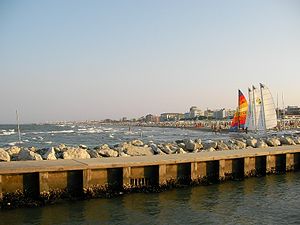Milano Marittima
| Milano Marittima | |||
|---|---|---|---|

|
|||
| Milano Marittima beach | |||
| Country | Italy | ||
| region | Emilia-Romagna | ||
| province | Ravenna (RA) | ||
| local community | Cervia | ||
| Coordinates | 44 ° 17 ' N , 12 ° 21' E | ||
| height | 3 m slm | ||
| Residents | 1,515 (Dec. 31, 2016) | ||
| patron | San Paterniano | ||
| Telephone code | 0544 | CAP | 48015 |
Milano Marittima (free German translation: Milan by the sea ) is a fraction of the Italian municipality ( comune ) Cervia in the province of Ravenna , Emilia-Romagna region . The popular seaside resort was founded in 1911 and lives mainly from tourism .
Origin and development of Milano Marittima
The birth and development of Milano Marittima go back to the early years of the 20th century, when Cervia was still a small town of 9000 inhabitants and based on a backward economy. It was largely dependent on salt production, agriculture and fishing, and the majority of its residents were illiterate and unemployed.
In the last 20 years of the 19th century, however, the first pioneering phase of tourism development had already begun, favored by an improvement in the hygienic and sanitary conditions of a territory to which malaria was still attributed and also by the construction of a rail link; In 1884 only the Ravenna - Cervia route, then in 1889 Ferrara - Ravenna - Rimini.
The first bathing establishment was built in 1882, so that Cervia became a bathing resort. In 1907, a convention was signed between the local government of Cervia and the Maffei, one of the most important Milanese bourgeois families - a contract according to which the municipality of Cervias made a large area of coastal land available to the Lombard society, with the condition that the concessionaire had villas, To build parks and gardens to create a new seaside resort. This seaside resort was called Milano Marittima, a name that all too well expresses the close connection to the Milanese ambience.
On June 1, 1911, the Società Milano Marittima per lo sviluppo della spiaggia di Cervia was founded , a society devoted to the development of the beach and whose members included the commander Napoleone Tempini, Aldo Tagliazucchi, the Senator Giovanni Facheris, the Lawyer Alberto Rendenti, Felice Bianchi, Giuseppe Galli and the painter and poster painter Giuseppe Palanti.
Giuseppe Palanti in particular adopted the theories of a garden city from Ebenezer Howard at that time . It is a very unusual city project that marked the development of a new city, whose tourist apartments should fit in optimally with the surrounding nature. It was a modern city where the middle class of the Lombard bourgeoisie spent their holidays; completely built on a series of small villas embedded in the lush pine forest.
Palanti's house must also be mentioned, one of the first villas to be built, which can still be admired today in Via 2 Giugno (corner of Via Toti). So a remarkable urban development began which, despite the interruption by the First World War , continued more and more obviously.
On October 20th, 1927, Cervia was recognized as a spa and tourist resort by the Enabling Act of the Ministry, thanks to the contribution of the new Milano Marittima locality. From this year onwards, not only did the construction of villas in the pine forest continue, but the first hotels, holiday centers and restaurants were also built.
The tourist development intensified in the 1930s, only to be interrupted again, this time by the Second World War . After the war, however, it continued and made the location one of the most renowned bathing centers in Italy.